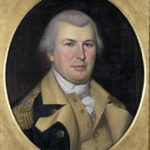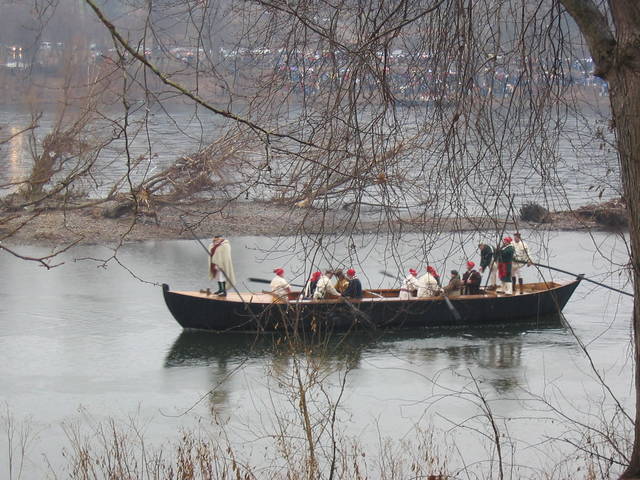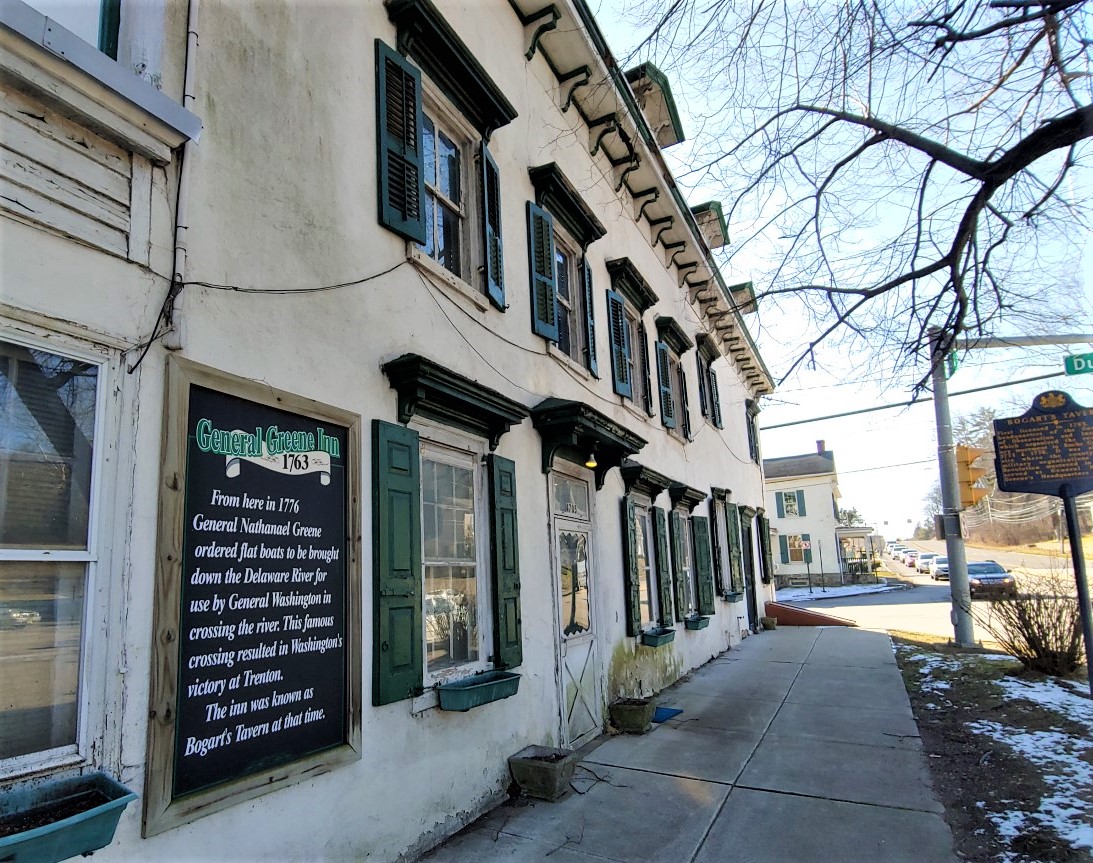Shuttered Gen. Greene Inn is perhaps the most historic building in Bucks County.
I must have passed the three-story General Greene Inn in Buckingham hundreds of times coming and going from Doylestown. The former Bogart Tavern with its distinctive French mansard roof looms snugly over the intersection of busy York and Durham roads. To have survived for 257 years is amazing having been closed for decades. Recently Cindy Furst of Newtown contacted me about the inn. She just read “1776″ by esteemed historian David McCullough. “Having worked in Buckingham for many years, I was aware that an old building on the corner of Rte. 263 and Rte. 413 had a marker that mentions it to be the headquarters of Gen. Greene, but I was astonished to realize this was the place where the crossing was planned by Washington’s top general.”

Well, not exactly. Let’s backtrack.
At the beginning of the American Revolution, Nathanael Greene was a Rhode Island foundry owner, politician and militia general who joined the Continental Army. There he became a close friend and confidant of George Washington. As brigadier general, Greene, 33, earned accolades by driving back British forces in the Battle of Harlem Heights in New York in September 1776. Two months later however, he accepted blame for convincing Washington to hold Fort Washington and Fort Lee on the Hudson River which fell to the British with the capture of 2,800 American troops. The twin defeats put the remainder of the Continental Army including Greene in flight across New Jersey to Bucks County in early December. The British army was in hot pursuit intent on finishing Washington and seizing Philadelphia. The general ordered all boats on the Jersey side of the Delaware removed to Bucks County or burned. Unable to cross, the Brits retreated to North Jersey for the winter, leaving a garrison of well-trained German mercenary soldiers in Trenton and Bordentown to prevent counterattack.

Meanwhile, the “Committee of Observation” had been meeting for some time in the 10-year-old Bogart Tavern to prepare Bucks for the Revolution. It urged locals not to buy British goods plus compiled names of “Associators” who participated in military exercises and “Non-Associators” who refused. From the latter, the committee collected firearms for use by the county’s first company of soldiers who mustered at the tavern in 1775 before joining the Continental Army.
All these activities were plotted amid widespread opposition – either Quakers wanting not to take sides or farmers and mill owners who opposed independence. Washington constantly worried he and his army would be betrayed. “We are in a Neighbourhood of very disaffected People,” he noted from Morrisville where he began planning an attack on Trenton. Gen. Greene made his headquarters at Bogart Tavern and soon met there with Washington who sketched out his strategy. Greene, in charge of army logistics, issued written orders at the tavern on Dec. 10 for “sixteen Durham boats and flats down to McConkey’s ferry (today’s Washington Crossing).” The vessels would be used in Washington’s famed Christmas crossing of the Delaware.

Greene moved his headquarters 5 miles north of the tavern to the home of Samuel Merrick on Eagle Road in Upper Makefield to be closer to thousands of troops encamped below New Hope. Washington similarly relocated from Morrisville to the home of William Keath on Pineville Road, a quarter mile from Greene’s residence. Both headquarters were a few miles inland from McConkey’s Ferry.
On Christmas Eve, Washington convened a top-secret meeting at Greene’s headquarters to finalize the plan of attack on Trenton. It’s there Washington gave officers the password to be used during the river crossing the following night: “Victory or Death”. Greene would lead the left flank of the army to victory in Trenton, turning the course of the Revolution. Greene’s later triumphs in the Carolinas set the stage for Washington’s decisive victory at Yorktown in 1781.
No one after the war paid much attention to the history of Bogart Tavern. But in 1913, a local historian discovered what had occurred there including Greene’s brief stay. Subsequently, the expanded, 30-room hotel was renamed the General Greene Inn. State government put up a roadside historical marker out front. Today, the building is privately owned, closed and in sad shape on its commercially-zoned, 5.6-acre property. Past developers have proposed bulldozing the inn for a shopping center. Lois Meyer and her family who have owned the building since 1928 have rejected offers that don’t include restoration. But time marches on. In 2005, Lois and her mother Edna wrote the Buckingham supervisors. “As best we can determine there is no prohibition whatsoever about demolishing the inn should a future owner of the property wish to do so in their development plans. Our personal feelings are the inn should be restored and be an important part of the township.”
Here’s hoping a community effort will make that possible.
Sources include “The Old General Greene Inn” by historian Terry A. McNealy available on the web at http://www.buckinghampa.org/general-information/township-history.aspx; “1776″ by David McCullough published in 2005; “History of Bucks County from the Discovery of the Delaware to the present time” by W.W.H. Davis published in 1905, and McNealy’s “A History of Bucks County Part 1″ published in 1970 by the Bucks County Historical-Tourist Commission. A file at the Buckingham Township municipal building has extensive documents relating to the inn. A tip of the hat to building inspector Jim Kettler for enabling me to access them.

